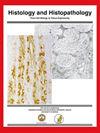Elisabeth Dingendorf, Marit Bernhardt, Isabella Federica Bollen, Tobias Kreft, Anna Katrin Scherping, Xiaolin Zhou, Manuel Ritter, Jörg Ellinger, Carsten Stephan, Glen Kristiansen
求助PDF
{"title":"CD63是前列腺癌的诊断标志物,也是根治性前列腺切除术后生化进展的预后标志物。","authors":"Elisabeth Dingendorf, Marit Bernhardt, Isabella Federica Bollen, Tobias Kreft, Anna Katrin Scherping, Xiaolin Zhou, Manuel Ritter, Jörg Ellinger, Carsten Stephan, Glen Kristiansen","doi":"10.14670/HH-18-981","DOIUrl":null,"url":null,"abstract":"<p><strong>Aims: </strong>We aimed to analyze CD63, a cell surface protein that has been associated with tumor aggressiveness in several cancers, including breast, colorectal, and lung cancer, as well as melanoma, in prostate cancer.</p><p><strong>Methods: </strong>CD63 expression was analyzed immunohistochemically in a cohort of primary prostate cancers from 281 patients. The results were correlated with clinico-pathologic parameters, including biochemical recurrence. In addition, CD63 expression in 251 of the 281 patients with prostate cancer was compared with CD63 expression in matched benign tissue samples (490 tissue samples). The analysis was performed automatically using the open-source software QuPath<sup>©</sup> and tested for statistical significance. For comparison with the diagnostic markers AMACR and GOLPH2, CD63 was analyzed in an additional cohort of 198 Prostate cancers.</p><p><strong>Results: </strong>CD63 expression was found in 100% of prostate cancer cases and benign tissue spots. Increased CD63 expression was significantly associated with higher tumor stage (pT), tumor grade (ISUP), as well as shorter progression-free survival (PFS). Compared with the CD63 intensity of benign tissue, expression in tumor tissue was higher in >80% of cases. In addition, combining the expression of CD63 and AMACR, positivity reached 97.2%, making CD63 a promising diagnostic biomarker in challenging cases.</p><p><strong>Conclusions: </strong>CD63 is commonly overexpressed in prostate cancer, and higher levels are associated with earlier biochemical tumor progression; hence, CD63 is a promising diagnostic and prognostic biomarker in primary prostate cancer.</p>","PeriodicalId":13164,"journal":{"name":"Histology and histopathology","volume":" ","pages":"18981"},"PeriodicalIF":2.0000,"publicationDate":"2025-09-08","publicationTypes":"Journal Article","fieldsOfStudy":null,"isOpenAccess":false,"openAccessPdf":"","citationCount":"0","resultStr":"{\"title\":\"CD63 is a diagnostic marker of prostate cancer and a prognostic marker of biochemical progression following radical prostatectomy.\",\"authors\":\"Elisabeth Dingendorf, Marit Bernhardt, Isabella Federica Bollen, Tobias Kreft, Anna Katrin Scherping, Xiaolin Zhou, Manuel Ritter, Jörg Ellinger, Carsten Stephan, Glen Kristiansen\",\"doi\":\"10.14670/HH-18-981\",\"DOIUrl\":null,\"url\":null,\"abstract\":\"<p><strong>Aims: </strong>We aimed to analyze CD63, a cell surface protein that has been associated with tumor aggressiveness in several cancers, including breast, colorectal, and lung cancer, as well as melanoma, in prostate cancer.</p><p><strong>Methods: </strong>CD63 expression was analyzed immunohistochemically in a cohort of primary prostate cancers from 281 patients. The results were correlated with clinico-pathologic parameters, including biochemical recurrence. In addition, CD63 expression in 251 of the 281 patients with prostate cancer was compared with CD63 expression in matched benign tissue samples (490 tissue samples). The analysis was performed automatically using the open-source software QuPath<sup>©</sup> and tested for statistical significance. For comparison with the diagnostic markers AMACR and GOLPH2, CD63 was analyzed in an additional cohort of 198 Prostate cancers.</p><p><strong>Results: </strong>CD63 expression was found in 100% of prostate cancer cases and benign tissue spots. Increased CD63 expression was significantly associated with higher tumor stage (pT), tumor grade (ISUP), as well as shorter progression-free survival (PFS). Compared with the CD63 intensity of benign tissue, expression in tumor tissue was higher in >80% of cases. In addition, combining the expression of CD63 and AMACR, positivity reached 97.2%, making CD63 a promising diagnostic biomarker in challenging cases.</p><p><strong>Conclusions: </strong>CD63 is commonly overexpressed in prostate cancer, and higher levels are associated with earlier biochemical tumor progression; hence, CD63 is a promising diagnostic and prognostic biomarker in primary prostate cancer.</p>\",\"PeriodicalId\":13164,\"journal\":{\"name\":\"Histology and histopathology\",\"volume\":\" \",\"pages\":\"18981\"},\"PeriodicalIF\":2.0000,\"publicationDate\":\"2025-09-08\",\"publicationTypes\":\"Journal Article\",\"fieldsOfStudy\":null,\"isOpenAccess\":false,\"openAccessPdf\":\"\",\"citationCount\":\"0\",\"resultStr\":null,\"platform\":\"Semanticscholar\",\"paperid\":null,\"PeriodicalName\":\"Histology and histopathology\",\"FirstCategoryId\":\"99\",\"ListUrlMain\":\"https://doi.org/10.14670/HH-18-981\",\"RegionNum\":4,\"RegionCategory\":\"生物学\",\"ArticlePicture\":[],\"TitleCN\":null,\"AbstractTextCN\":null,\"PMCID\":null,\"EPubDate\":\"\",\"PubModel\":\"\",\"JCR\":\"Q3\",\"JCRName\":\"CELL BIOLOGY\",\"Score\":null,\"Total\":0}","platform":"Semanticscholar","paperid":null,"PeriodicalName":"Histology and histopathology","FirstCategoryId":"99","ListUrlMain":"https://doi.org/10.14670/HH-18-981","RegionNum":4,"RegionCategory":"生物学","ArticlePicture":[],"TitleCN":null,"AbstractTextCN":null,"PMCID":null,"EPubDate":"","PubModel":"","JCR":"Q3","JCRName":"CELL BIOLOGY","Score":null,"Total":0}
引用次数: 0
引用
批量引用
CD63 is a diagnostic marker of prostate cancer and a prognostic marker of biochemical progression following radical prostatectomy.
Aims: We aimed to analyze CD63, a cell surface protein that has been associated with tumor aggressiveness in several cancers, including breast, colorectal, and lung cancer, as well as melanoma, in prostate cancer.
Methods: CD63 expression was analyzed immunohistochemically in a cohort of primary prostate cancers from 281 patients. The results were correlated with clinico-pathologic parameters, including biochemical recurrence. In addition, CD63 expression in 251 of the 281 patients with prostate cancer was compared with CD63 expression in matched benign tissue samples (490 tissue samples). The analysis was performed automatically using the open-source software QuPath© and tested for statistical significance. For comparison with the diagnostic markers AMACR and GOLPH2, CD63 was analyzed in an additional cohort of 198 Prostate cancers.
Results: CD63 expression was found in 100% of prostate cancer cases and benign tissue spots. Increased CD63 expression was significantly associated with higher tumor stage (pT), tumor grade (ISUP), as well as shorter progression-free survival (PFS). Compared with the CD63 intensity of benign tissue, expression in tumor tissue was higher in >80% of cases. In addition, combining the expression of CD63 and AMACR, positivity reached 97.2%, making CD63 a promising diagnostic biomarker in challenging cases.
Conclusions: CD63 is commonly overexpressed in prostate cancer, and higher levels are associated with earlier biochemical tumor progression; hence, CD63 is a promising diagnostic and prognostic biomarker in primary prostate cancer.

 求助内容:
求助内容: 应助结果提醒方式:
应助结果提醒方式:


